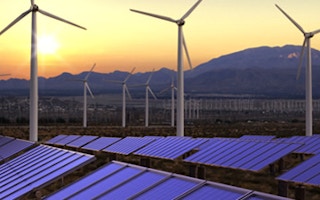The global clean energy sector could hit $1.9 trillion in total revenue from 2012 to 2018 as energy consumption is expected to increase in the coming years, said a new study released by the Pew Charitable Trusts.
Pew’s study, titled “ Innovate, Manufacture, Compete: A clean energy action plan,” projected that revenue associated with the installation of wind, solar, and other renewable power is expected to grow at a compound annual rate of eight per cent, rising annually from $200 billion in 2012 to $327 billion by 2018.
Renewable energy sources such as solar, wind and other clean electric generation technologies accounted for almost half of all generating capacity added to the world’s power sector, the study said.
The world’s leading economies (members of the bloc known as G20 or Group of 20) dominate the sector, accounting for 95 per cent of all global investments in clean energy, but investment and deployment in parts of Africa, Asia, and Latin America are expected to grow by 10 to 20 per cent annually over the next decade, it added.
US lags behind in clean energy race
The Pew study also pointed out that though the future of clean energy globally is bright, the forecast for the United States’ position in this fast-growing marketplace is less certain.
“ Our research shows that there is a multi-trillion-dollar opportunity in the clean energy sector, “ said Pew’s Clean Energy Program Director Phyllis Cuttino, in a statement released on Thursday.
“ The United States industry has the capacity to be a leader, provided we have the right policies in place. It’s time for Congress to support a comprehensive energy strategy by delivering long-term certainty for businesses and investors in renewable power.”
Countries in Asia and Europe are placing a priority on development and deployment of clean energy technologies and competitive enterprises. This means, according to the study, a robust international trade in clean energy goods and services, with expanding markets are opening up opportunities for a variety of US interests. But it also means that the US must increase its pace to compete in the international race for economic leadership.
According to the study, revenue in the US market on an annual basis is expected to grow over the period at a compound annual rate of 14 per cent.
Solar revenue in the US is forecast to grow at a rate of 11 per cent annually, increasing from $11 billion in 2012 to $21 billion in 2018. In the wind sector, onshore generating capacity is forecast to increase, from $14 billion in 2012 to $19.2 billion in 2018. Annual revenues associated with biomass electric power installations are forecast to grow to $3 billion in 2018, from $1 billion in 2012.
In solar manufacturing, the early US lead in this rapidly emerging sector has steadily eroded. Over the past decade, manufacturing leadership has shifted from the United States to Japan, Europe, and, more recently, Asia.
The study noted that in 2011, 11 of the top 15 solar PV module manufacturers were located in Asia, with Chinese and Taiwanese manufacturers accounting for more than 60 percent of worldwide production (an increase from 50 percent in 2010).
More recently, China has emerged as a major center of wind turbine manufacturing. In 2011, 10 wind turbine manufacturers accounted for 80 percent of the global market: four from Europe (Denmark, Spain, and Germany—a combined 35.3 percent market share), four from China (26.7 percent market share), one from the United States (8.8 percent market share), and one from India (7.7 percent market share).
China domination
“ The dramatic and determined push by China for leadership in the clean energy marketplace is alarming to US industry insiders who believe that policymakers underestimate the scale of China’s clean energy ambitions,” the Pew study noted.
China has established a goal of obtaining 15 percent of its energy from non-fossil sources by 2020, a dramatic increase from just 2 percent in 2010.
In less than a decade, the country has become the world’s largest wind market and may soon be the largest solar market.
Overall, there is broad consensus that China is working to become the dominant global producer of both solar and wind technologies, which account for the overwhelming majority of the world’s clean energy investment.
Clean energy innovation
While it is widely recognized that the United States has been at the forefront of clean energy research and development (R&D), US leadership in the innovation arena is being challenged, especially by emerging economies in Asia, the Pew said.
“ Policies that encourage the deployment, innovation, manufacturing, and trade of clean energy technologies will help bolster the competitive prospects of American industry. In the process, these initiatives will enhance the nation’s economic, environmental, and national security prospects,” the study added.
Some of the recommendations made by the Pew study are the following:
- to establish a clean energy standard to guide deployment and investment for the long term;
- significantly increase investment in energy research and development;
- enact a multi-year but time-limited extension of tax credits for clean energy sources;
- level the playing field across the energy sector by evaluating barriers to competition;
-renew incentives for domestic clean energy manufacturing and create a strategy to expand markets for clean energy goods and services abroad.
Click here to read the full report of Pew Charitable Trusts’ study, titled “ Innovate, Manufacture, Compete: A clean energy action plan”








